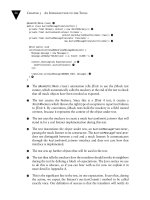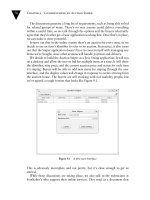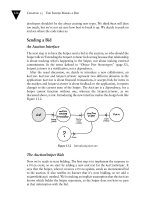Applied Software Project Management - PROJECT SCHEDULES pdf
Bạn đang xem bản rút gọn của tài liệu. Xem và tải ngay bản đầy đủ của tài liệu tại đây (347.98 KB, 32 trang )
Applied Software Project Management
PROJECT
SCHEDULES
Applied Software Project
Management
04:53:13 PM
1
Applied Software Project Management
WHAT IS A PROJECT SCHEDULE?
The
project schedule
is a calendar that links the tasks to be done with
the resources that will do them.
Before a project schedule can be created, the project manager must have a work
breakdown structure (WBS) and estimates.
The schedule is part of the project plan.
04:53:13 PM
2
Applied Software Project Management
SCHEDULING CONCEPTS: EFFORT VS.
DURATION
Effort
represents the work required to perform a task.
Effort is measured in person-hours (or person-days, person-weeks, etc.)
It represents the total number of hours that each person spent working
on the task.
Duration
is amount of time that elapses between the time the
task is started and the time it is completed.
Duration is measured in hours (or days, weeks, etc.)
It does not take into account the number of people performing the task
04:53:14 PM
3
Applied Software Project Management
SCHEDULING CONCEPTS:
SLACK AND OVERHEAD
Slack
is the amount of time which any of the tasks can be delayed without causing the
due date of the final task in the sequence to be delayed as well.
A tight schedule has very little slack; a delay in any task will cause a delay in the due date
Parkinson’s Law: “Work expands so as to fill the time available for its completion.”
Float
Overhead
is any effort that does not go to the core activities of the task but is still
required in order for the people to perform it—a sort of “real world” cost of
actually doing the work.
Two people performing a task will require more effort than one person doing the same task
Assigning two people to the task requires more effort, but the task has a shorter duration
if the duration of a task is 12 days, it may require 7 days for 2 people to finish it
04:53:14 PM
4
Applied Software Project Management
MILESTONES
04:53:14 PM
5
Applied Software Project Management
MILESTONES
A control point event in the project, usually the completion of a key
deliverable, that triggers a reporting requirement or that requires
sponsor or customer approval before proceeding with project.
04:53:14 PM
6
Applied Software Project Management
BUILDING THE PROJECT SCHEDULE
Allocate resources
For each task in the WBS, one or more resources must be assigned
Choose person or people for each task based on qualifications, familiarity and
availability
Take overhead into account when calculating the duration of each task
04:53:15 PM
7
Applied Software Project Management
BUILDING THE PROJECT SCHEDULE
Identify dependencies
A task has a dependency if it involves an activity, resource or work product which is
subsequently required by another task
Tasks may have dependencies because they require the same resource
04:53:15 PM
8
Applied Software Project Management
BUILDING THE PROJECT SCHEDULE
Identify dependencies (continued)
Every dependency has a
predecessor
, or a task that must be begun,
in progress, or completed, for another task to begin
Identify the type of predecessor for each dependency
04:53:15 PM
9
Applied Software Project Management
BUILDING THE PROJECT SCHEDULE
Create the schedule
Most project schedules
are represented using a
Gantt chart
The Gantt chart shows
tasks, dependencies and
milestones using
different shapes
04:53:15 PM
10
Applied Software Project Management
The most common form for the schedule to take is a Gantt chart. This
is a type of bar chart developed by Henry Laurence Gantt, an American
engineer who was prominent during the first two decades of the 20
th
century.
Over the past century, Gantt charts have been used on major civil
engineering projects (including the Hoover Dam and the U.S. interstate
highway system), and it is now the standard way to document software
project schedules
04:53:16 PM
11
Applied Software Project Management
SCHEDULING TECHNIQUES
PERT
CPM
04:53:16 PM
12
Applied Software Project Management
PERT
Program Evaluation and Review Technique, commonly abbreviated
PERT
a graphic representation of a project’s schedule, showing the sequence of
tasks,
which tasks can be performed simultaneously,
the critical path of tasks that must be completed on time in order for the
project to meet its completion deadline.
The chart can be constructed with a variety of attributes, such as earliest
and latest start dates for each task, earliest and latest finish dates for each
task, and slack time between tasks.
A PERT chart can document an entire project or a key phase of a project.
The chart allows a team to avoid unrealistic timetables and schedule
expectations, to help identify and shorten tasks that are bottlenecks, and to
focus attention on most critical tasks.
It is commonly used in conjunction with the critical path method or CPM.
04:53:16 PM
13
Applied Software Project Management
Task #1: 2 days duration, Task #2,…
Dependency: Task #2, #3 must be completed before Task #4
04:53:16 PM
14
Applied Software Project Management
WORK PACKAGE DEPENDENCY
RELATIONSHIPS
Relationship Description
Finish-to-Start Preceding activity must finish
before the succeeding activity can
start
Finish-to-Finish Preceding activity must finish
before the succeeding activity can
finish
Start-to-Start Preceding activity must start
before the succeeding activity can
start
Start-to-Finish Preceding activity must finish
before the succeeding activity can
finish
04:53:17 PM
15
Applied Software Project Management
PERT
PERT is networking technique that has four defining characteristics
All WBS must be placed in a network diagram
Show all of the dependencies and paths to completion
3 time estimates must be made for each work package
F=Optimistic + 4 x Most Likely + Pessimistic/6
Slack of float for each work package must be calculated and the critical path
determined
04:53:17 PM
16
Applied Software Project Management
04:53:17 PM
17
Applied Software Project Management
CPM
In 1957, DuPont developed a project management method
designed. Given the complexity of the process, they developed
the Critical Path Method (CPM) for managing projects.
CPM provides the following benefits:
Provides a graphical view of the project.
Predicts the time required to complete the project.
Shows which activities are critical to maintaining the schedule and
which are not.
CPM models the activities and events of a project as a network.
Activities are depicted as nodes on the network and events that
signify the beginning or ending of activities are depicted as arcs or
lines between the nodes.
04:53:17 PM
18
Applied Software Project Management
IDENTIFY AND ANALYZE THE CRITICAL
PATH
The critical path is the longest-duration path through the network. The
significance of the critical path is that the activities that lie on it cannot
be delayed without delaying the project. Because of its impact on the
entire project, critical path analysis is an important aspect of project
planning.
04:53:18 PM
19
Applied Software Project Management
IDENTIFY AND ANALYZE THE CRITICAL
PATH
The critical path can be identified by determining the following four
parameters for each activity:
ES - earliest start time: the earliest time at which the activity can start given that its
precedent activities must be completed first.
EF - earliest finish time, equal to the earliest start time for the activity plus the time
required to complete the activity.
LF - latest finish time: the latest time at which the activity can be completed without
delaying the project.
LS - latest start time, equal to the latest finish time minus the time required to
complete the activity.
04:53:18 PM
20
Applied Software Project Management
04:53:18 PM
21
Applied Software Project Management
IDENTIFY AND ANALYZE THE CRITICAL
PATH
The
slack time
The critical path is the path through the project network in which none
of the activities have slack, that is, the path for which ES=LS and EF=LF
for all activities in the path. A delay in the critical path delays the
project. Similarly, to accelerate the project it is necessary to reduce the
total time required for the activities in the critical path.
04:53:18 PM
22
Applied Software Project Management
The forward pass: calculate the Early Start (ES), Early Finish (EF)
Start with the first activity
ES for the first activity = 0
EF for the first activity is its duration
ES = latest EF of any of its predecessor activities
EF = latest EF of any of its predecessor activities + duration
Move forward
The backward pass: calculate the Late Start (LS) and the Late Finish (LF).
Start with last activity
LF for the last activity equals its EF time
LS for the last activity equals its EF-its duration
LF for any predecessor activity equals the earliest LS of any of its successors
LS for any predecessor activity equals its LF minus duration
Move backward
Float = LF-EF
04:53:19 PM
23
Applied Software Project Management
04:53:19 PM
24
Applied Software Project Management
How long from start (A) to finish (L)?
What would happen if AE takes 8 days?
An activity is critical if:
a delay in it delays the entire project
What activities are critical in the fig.?
04:53:19 PM
25









